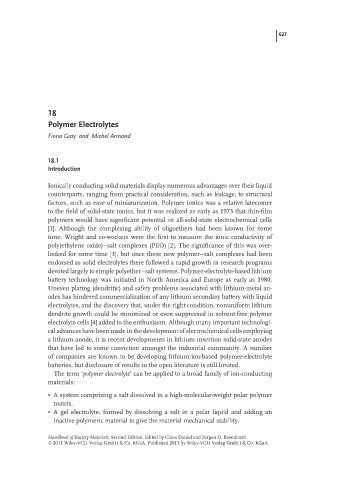Page 653 - Handbook of Battery Materials
P. 653
627
18
Polymer Electrolytes
Fiona Gray and Michel Armand
18.1
Introduction
Ionically conducting solid materials display numerous advantages over their liquid
counterparts, ranging from practical consideration, such as leakage, to structural
factors, such as ease of miniaturization. Polymer ionics was a relative latecomer
to the field of solid-state ionics, but it was realized as early as 1973 that thin-film
polymers would have significant potential in all-solid-state electrochemical cells
[1]. Although the complexing ability of oligoethers had been known for some
time, Wright and co-workers were the first to measure the ionic conductivity of
poly(ethylene oxide)–salt complexes (PEO) [2]. The significance of this was over-
looked for some time [3], but once these new polymer–salt complexes had been
endorsed as solid electrolytes there followed a rapid growth in research programs
devoted largely to simple polyether–salt systems. Polymer-electrolyte-based lithium
battery technology was initiated in North America and Europe as early as 1980.
Uneven plating (dendritic) and safety problems associated with lithium-metal an-
odes has hindered commercialization of any lithium secondary battery with liquid
electrolytes, and the discovery that, under the right condition, nonuniform lithium
dendrite growth could be minimized or even suppressed in solvent-free polymer
electrolyte cells [4] added to the enthusiasm. Although many important technologi-
cal advances have been made in the development of electrochemical cells employing
a lithium anode, it is recent developments in lithium insertion solid-state anodes
that have led to some conviction amongst the industrial community. A number
of companies are known to be developing lithium-ion-based polymer-electrolyte
batteries, but disclosure of results in the open literature is still limited.
The term ‘polymer electrolyte’ can be applied to a broad family of ion-conducting
materials:
• A system comprising a salt dissolved in a high-molecular-weight polar polymer
matrix.
• A gel electrolyte, formed by dissolving a salt in a polar liquid and adding an
inactive polymeric material to give the material mechanical stability.
Handbook of Battery Materials, Second Edition. Edited by Claus Daniel and J¨ urgen O. Besenhard.
2011 Wiley-VCH Verlag GmbH & Co. KGaA. Published 2011 by Wiley-VCH Verlag GmbH & Co. KGaA.

